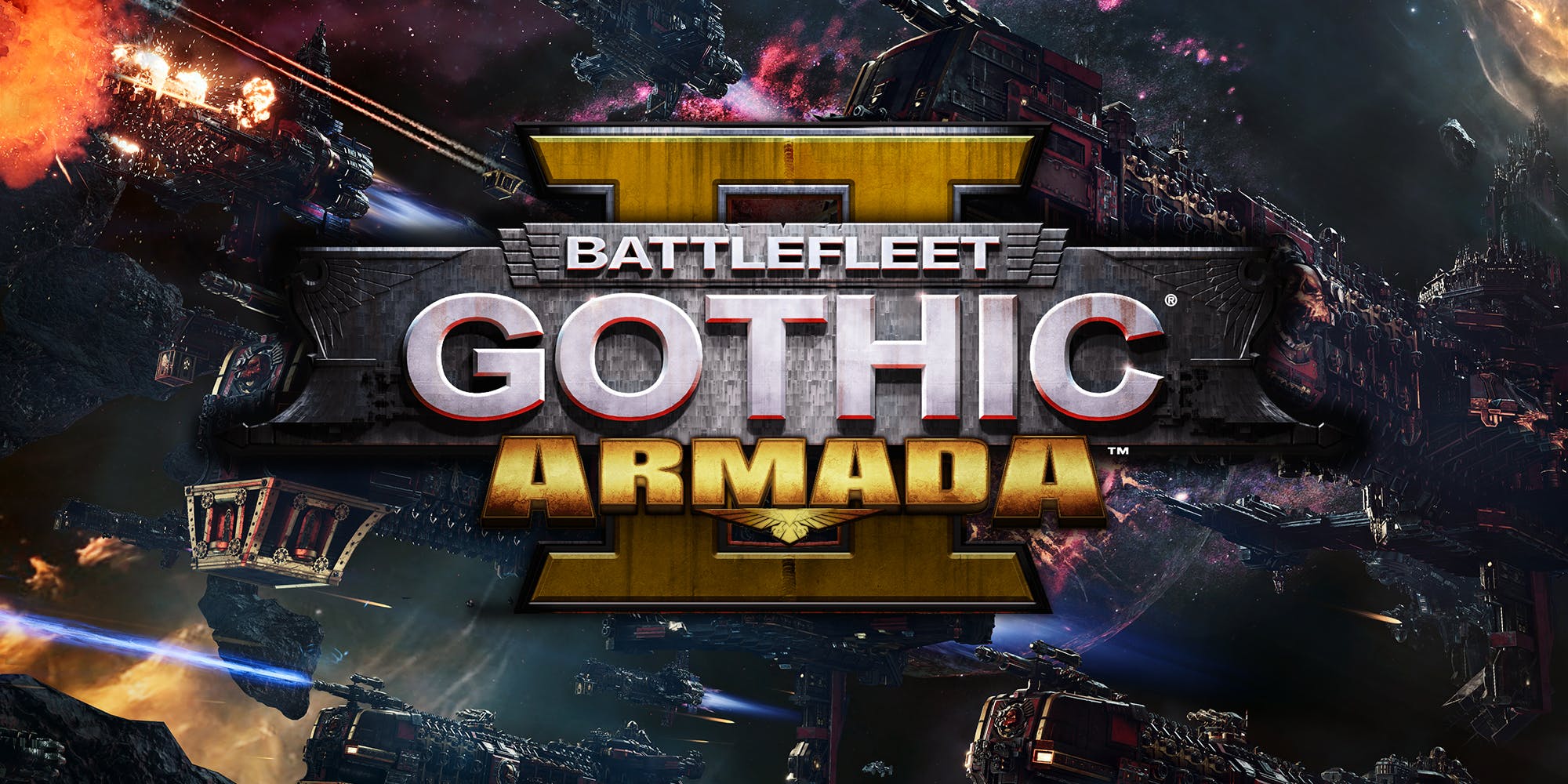
I must admit that I never actually got around to playing the original Battlefleet Gothic: Armada, despite being a fan of both 40k and RTS games. I actually own a copy of it on Steam, but like many of my Steam purchases, for one reason or another it has sat unplayed. As time dragged on and we heard rumblings of an even bigger and better sequel on the way, I eventually decided to wait and see what the next game has to offer. The result is a truly massive game that (as far as I can tell) improves on the original in some places, but also takes a few controversial steps back in an attempt to make the experience more streamlined for newcomers.
Battlefleet Gothic: Armada 2
Publisher: Focus Home Interactive
Developer: Tindalos Interactive
Platform: Windows PC (Reviewed)
Release Date: January 24th, 2019
Players: 1-4
Price: $39.99
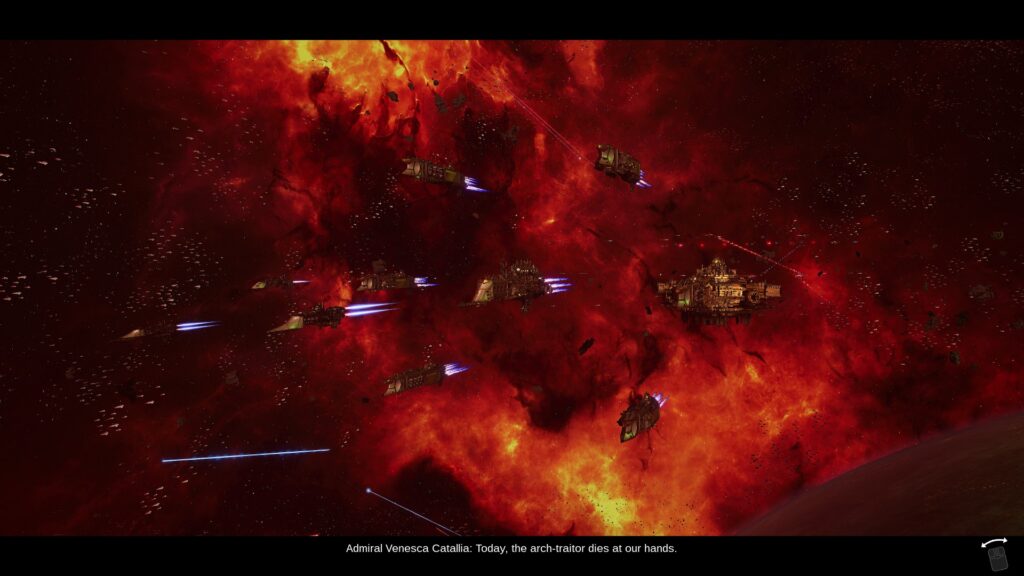
Battlefleet Gothic: Armada 2 is set in the immediate aftermath of Abaddon’s 13th Black Crusade, the apocalyptic war that finally saw Cadia break under the onslaught of the forces of Chaos. These are the events that led up to the current edition of the tabletop game, as well as the recent storyline that involves the reawakening of Primarch Roboute Guilliman and his grand crusade to reunite a shattered Imperium. It was a truly dire time in a universe renowned for being so grim and over-the-top that its become a meme at this point.
The game’s story is told across three massive campaigns, each of which can easily take dozens upon dozens of hours to complete. The Imperium campaign places you in control of Admiral Spire, a hero of the Gothic War and the main character of the previous game, who has spent the past 800 years trapped in the Immaterium in his relentless pursuit of Abaddon. His flagship finally reenters real space after Abaddon’s Black Legion used a captured Blackstone Fortress to annihilate Cadia, and he finds himself drawn into humanity’s effort to rally their scattered Imperial fleets and retake the sectors that fell to Chaos.
The Imperium campaign serves mostly as a gigantic tutorial to the game, gradually introducing players to new mechanics and concepts that they’ll need to learn to tackle the more advanced campaigns and multiplayer. The Necron and Tyranid campaigns both play quite differently, and feature less handholding. As the Necrons you’ll be controlling Amarkun the Gatherer, a servant of the Nepheru Dynasty that has begun to reawaken after 60 million years of stasis to find their tomb worlds crawling with the scouts and tech-priests of the Adeptus Mechanicus. As the Tyranids you are just really hungry and all those Imperial worlds look like big greasy burgers after a night of heavy drinking.
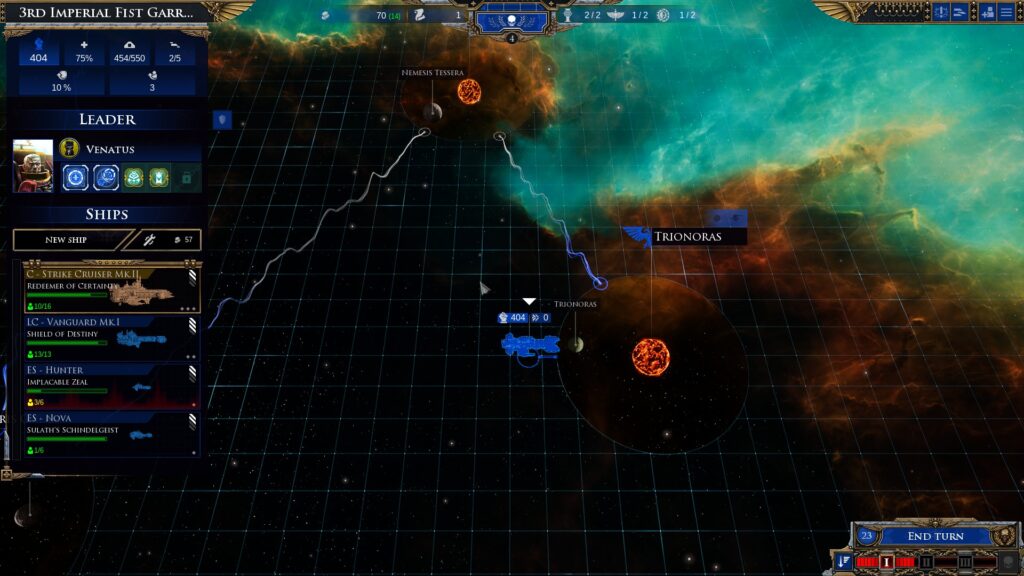
Whether you are trying to retake a besieged Imperium or devour all the tasty biomass in your path, all three grand campaigns generally involve moving fleets around a multi-level strategic map that includes tons of star systems, sectors, planets, and moons to conquer. Each sector will have multiple systems that are usually surrounded by enemy fleets you’ll need to defeat, with several overarching story missions to complete before moving on to the next sector.
Each system will have points of strategic interest, and will generate resources that can be spent on upgrading systems, fortifying your defenses with orbital platforms or space stations, and expanding your armada with new ships and fleets. Points of interest may include advanced star ports that can build larger ships, or traits that may affect the resource output or repair rates of that area.
One issue I encountered almost immediately is that the tooltips, UI, and general instructions of the game could use some tweaks. Sometimes it’s a bit unclear exactly how productive your economy is, what your overall upkeep and costs are, and how upgrades can affect your income. Then again, it could also just be that the actual empire management aspect of the game is fairly simplistic overall. This isn’t exactly a grand strategy game, and everything pretty much exists solely to get you to the fleet battles.
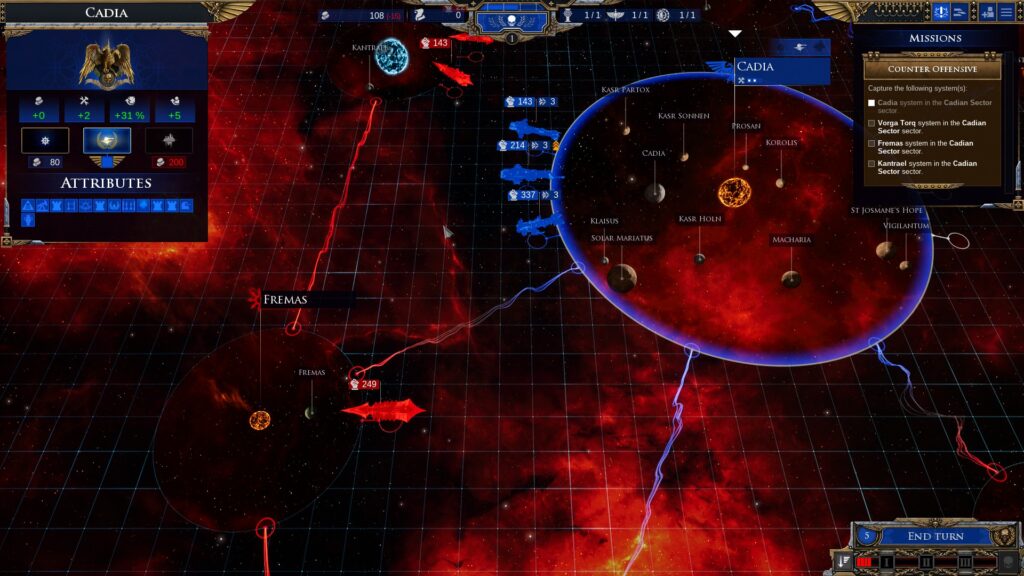
One area where Armada 2 is a definite step backwards from the original is the lack of individual ship customization during the campaign. Again, I didn’t play the original myself, but I do know that there was more to the ship and fleet progression than this. The leaders of your fleets will level up over time, and you’ll gain renown as you win battles and complete objectives that increase your fleet capacity, grant upgrade points to spend on fleetwide bonuses, and allow you to field larger and more advanced vessels, but there’s no individual ship customization like in the original.
This ultimately means that, aside from your leaders, your ships feel fairly expendable. The only real penalty for losing one is the resources cost, which can hurt early in the campaign, but gradually becomes less of an issue.
I must also say that, while each campaign is huge and loaded with content, there’s quite a bit of filler. As I said earlier, each sector will have a few objectives to complete that give you narration and push the story forward, but many of the battles will essentially just be standard skirmishes. Mission variety is pretty slim, with most battles being a Domination-style mode where you win by wiping out the enemy, or capturing strategic points and being the first to reach the point threshold.
Every now and then you will encounter some modifiers and random events, like uprisings on the strategic map, invasions by enemy factions, or meteor showers during a battle, but for the most part the campaigns are just about throwing fleets at enemy fleets in skirmish battles. That’s all fine and good, but I feel like the developers missed an opportunity to give us more exciting mission variety and a more frequently delivered narrative.
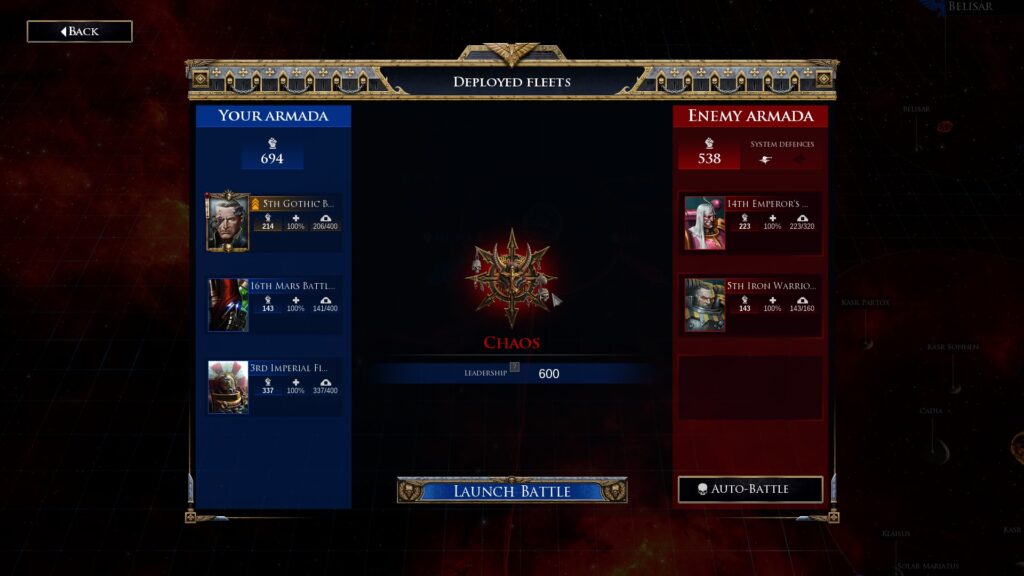
Battles in the campaign can consist of up to three fleets per side, but unfortunately there’s some really arbitrary restrictions in place. The game features a command limit that gradually increases as you gain more renown, which acts a bit like a point limit in the tabletop game. So if your command limit is 1000, you can only field 1000 points worth of ships in the battle, no matter how many ships you have across your fleets participating in the battle. The weird part is that any ships left over still get to participate, but only as you take losses, at which point ships left in reserve will spawn in your deployment zone as the battle rages on.
An issue related to this is that you can’t actually choose which ships to bring into the battle. Instead, the game auto-allocates ships, starting with the leaders of your fleets. This is a bizarre and frankly frustrating mechanic because it gives you no control over what ships get brought to the battle. The command limit in general feels like a very gamey concept. Sure, point limits are a fine way to balance competitive battles between players, but why does it exist against AI battles in the campaign? I want to smash heretics with half a dozen battleships and swarms of cruisers and escorts.
Complaints aside, the campaigns are still fun, and there’s tons of content to chew through in the three campaigns alone. Tindalos Interactive also announced that we’ll be getting a fourth campaign sometime later this year, just in case you didn’t feel like you got your money’s worth with just three campaigns in a single game.
But enough of that, lets talk about how fun the actual fleet combat is. After all, that’s what you’ll be spending most of your time doing in Armada 2. Each battle begins with you setting up your fleet in a deployment zone. Each faction has a fairly sizable number of ships at their disposal across several classes, ranging from tiny escort ships, up to gigantic battleships that look like cathedrals with thrusters that pack enough firepower to wipe out a small moon.
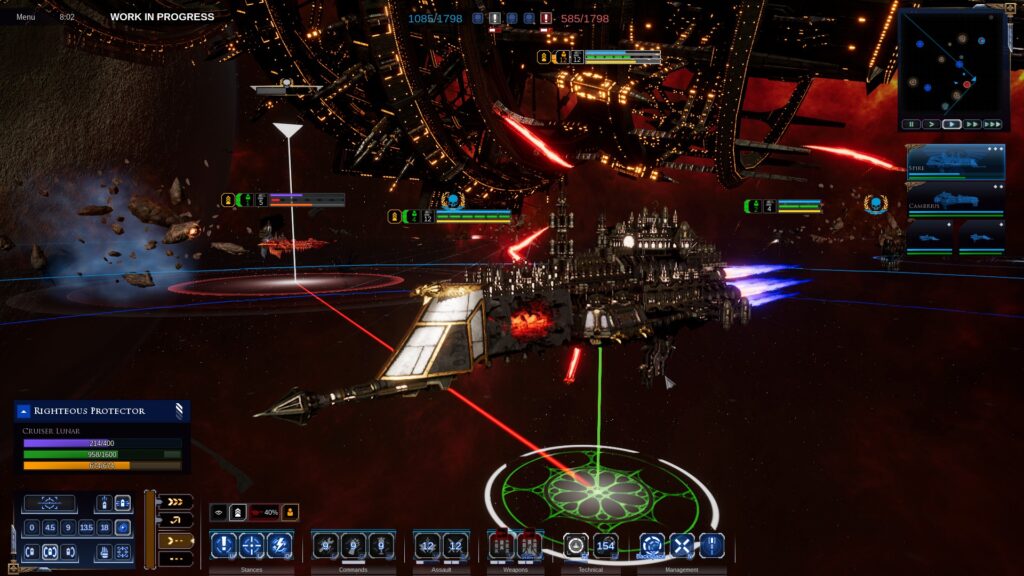
One thing you need to know right away before determining if Armada 2 is for you is that this is a very micro intensive game. You’ll need to maneuver your ships into optimum engagement ranges, avoid space debris and enemy abilities, keep track of your crew and systems, and fire off your own special weapons. You can also click enemy ships to set priority targets and focus fire on specific systems. You can enable some basic auto-engagement orders for your ships if all the micro gets too overwhelming, but ultimately you’ll need to learn to manage your ships manually to get the most out of them.
Each ship has a crew and systems that you’ll need to closely monitor, because as these systems are damaged, the performance of your ships will degrade. Light damage and small crew losses can be replaced with several special abilities, but once systems sustain heavy damage they can be disabled permanently. Killing a ship’s crew with various boarding abilities is also a viable strategy, reducing the ship to a drifting hulk unless the enemy has light transports that can be used to replace the ship’s crew and bring it back online.
While each ship is bristling with heavy firepower, many of your big damage dealers come in the form of limited use activatable abilities. The most common of these include various forms of torpedoes, fighter and bomber swarms, and bombardments from massive cannons and bombs. While guided missiles, boarding troops equipped with personal teleporters, and bombers are targeted abilities, many of the others must be manually aimed and usually have limited arcs, further emphasizing the game’s reliance on smart maneuvering and micromanagement. Weapons like Nova Cannons and Plasma Bombs have a moderately high learning curve due to the timing requirements involved, but that makes them all the more satisfying when they connect and obliterate a ship’s void shields.
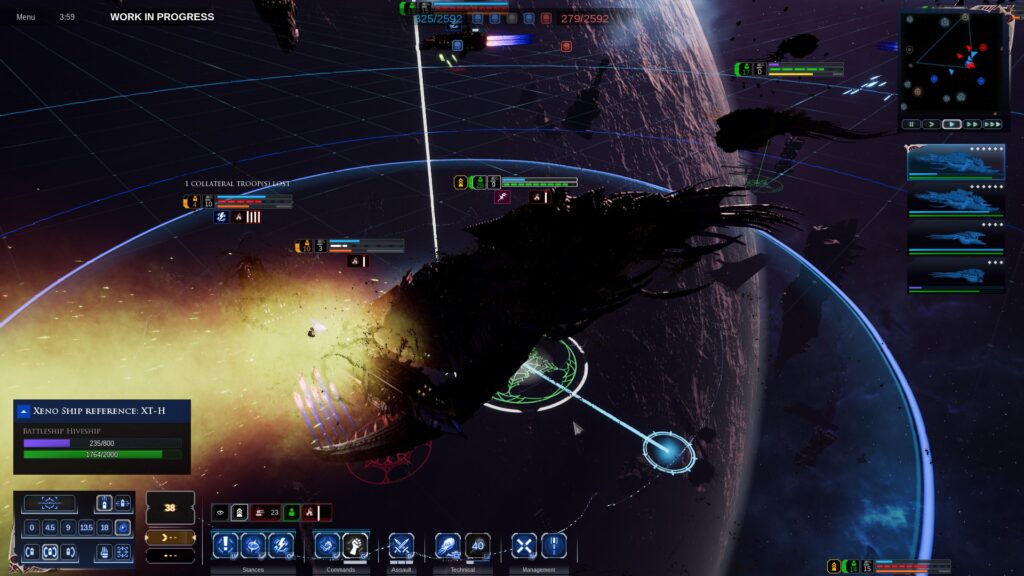
There’s other key abilities to learn too, like High Speed Turns, Full Burns, and stances that give the ship a temporary boost in a specific area. Brace For Impact, for example, fortifies a ship that’s about to do a high speed ramming maneuver. Many of these abilities also vary between factions. Necron ships can’t do Full Burns or High Speed Turns, but instead use a cooldown-based maneuver that allows them to teleport a short distance. Orks have the Big Red Button, which gives them a tremendous burst of speed to get somewhere fast, or to perform a particularly brutal ram attack.
All this comes together to create a combat system that has a pretty high learning curve, but rewards skillful maneuvering and micromanagement of your fleet. Each of the 12 factions also play quite differently and have a good variety of ships, ensuring that there’s tons of tactical options available when making your fleet. In AI skirmish and multiplayer you can also customize your flagship with two activatable abilities and two upgrades, roughly half of which are locked behind faction level tiers to give the game a bit of a progression system.
That may sound like it might give people who have played more hours an edge (and to a degree it kind of does), but the game does a decent enough job of ensuring that each of these are side grades that are less about straight-up increasing the power of your flagship, and more about allowing you to customize your fleet to fit specific playstyles.
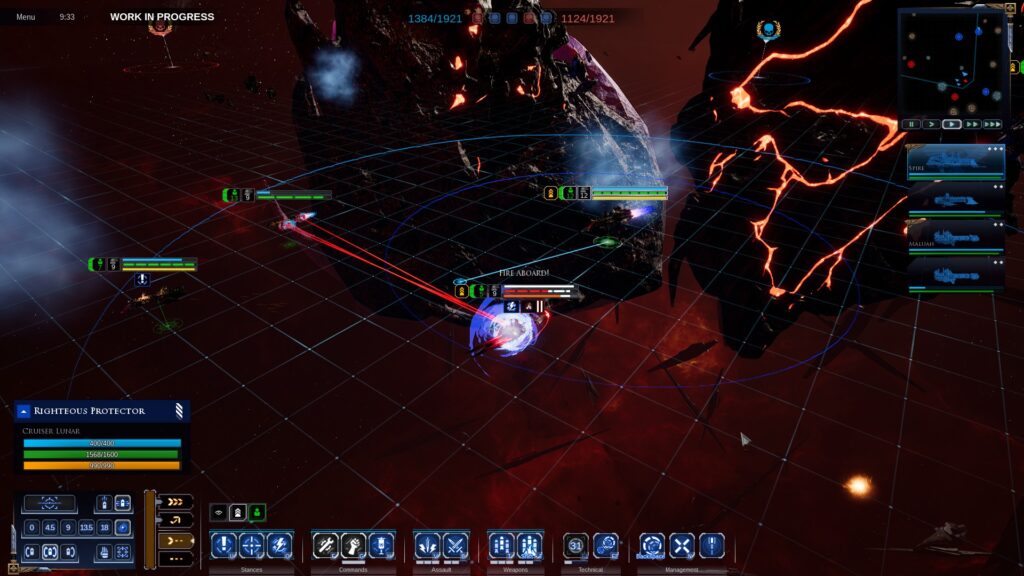
One unfortunate side effect of the sheer number of factions is that there’s certainly some balance issues that might need to be addressed in future patches. The Eldar are perhaps a bit too good at the Domination-style game mode that makes up the multiplayer component of the game. Their speedy yet fragile vessels are really good at zooming around the map capturing objectives, giving them an undeniable edge. Factions and ships focused on boarding operations are also quite powerful, allowing them to quickly reduce a flagship to a drifting hulk and inflicting a severe morale penalty on their opponents if they aren’t careful.
The biggest problem with the multiplayer and AI skirmish mode is, much like the campaign, the lack of game modes and mission variety. All you have access to is the aforementioned Domination-style capture point mode. There really needs to be more variety to keep things fresh. This is something that the developers have addressed somewhat by confirming that there will be an upcoming mode focused on massive, legendary super ships, but they still need to continue to develop more objective-focused modes to keep battles interesting and engaging. The maps are also a bit bland, as they are really just a skybox with capture points, a few asteroid or debris fields, and some clouds that ships can hide in. I know that there’s not much you can really do with the maps since they are in space, but it would be nice if there were more types of hazards or terrain to avoid and exploit.
The final, big flaw with Armada 2 is fleet size. Despite the promise of bigger and better battles, you still can’t build a particularly large fleet. A 1v1 game can have a decent number of vessels, but 2v2 is limited to 600 points per player, roughly half the size of 1v1 games. Some of the largest ships in the game are approaching that point cost, so if you want to field them you will have a very small force indeed. This ensures that a 2v2 match feels less like four fleets clashing, and more like four players splitting up control of two small fleets.
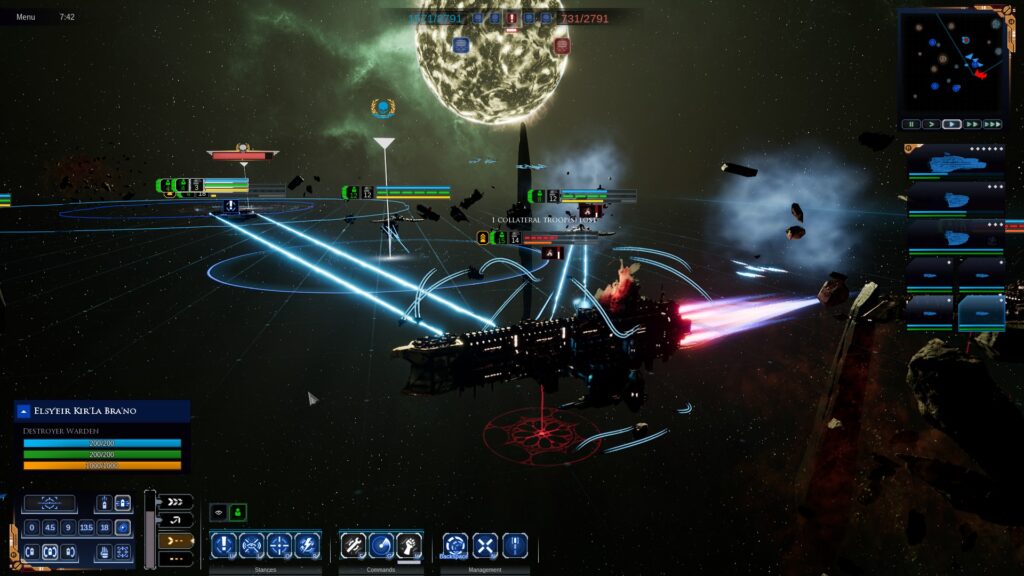
Granted, I can understand why the fleet sizes are fairly limited. As I’ve stressed throughout this review, Armada 2 is a very micromanagement intensive game. Every ship has multiple weapons and abilities to learn and manage, and balancing the games for large fleets in single player could prove to be quite difficult. However, I still think there’s a middle ground between the current point limits and an absurd level where you have to be a Korean StarCraft II pro to keep up with everything. At the very least, give us the option to form ridiculously large fleets if we want to, and have a more standardized size for competitive ranked matches.
As far as graphics, sound, and performance go, the game looks and runs fine. The skyboxes look great, though some can get a bit distracting with all the planets, stars, bases, and various space phenomenon in the background. One in particular had a massive moon creating an awkward glare on the map that felt like sunlight was peeking through the window and shining directly on my monitor.
The ships are nicely detailed and accurate recreations based on 40k‘s extensive artwork, lore, and the old Battlefleet Gothic miniatures. Torpedo volleys, Heavy Lance barrages, and Nova Cannon bombardments all look and sound great. The soundtrack consists of booming orchestral music and choirs that feels suitably 40k, and mesh well with the belching of heavy ordinance.
I’m running the game on a fairly modest PC (1070, i7-8700, 16GB) and the game normally stays over 60 FPS just fine, even in fairly chaotic battles. I have encountered a few scripted events that momentarily dropped the game below 50, but in normal gameplay the framerate stays fairly consistent. There is a weird issue where opening the shipyard in the campaign causes the game to freeze for a few seconds, however. This happens every time I try to open that menu, and I’ve seen other people complain about it as well.
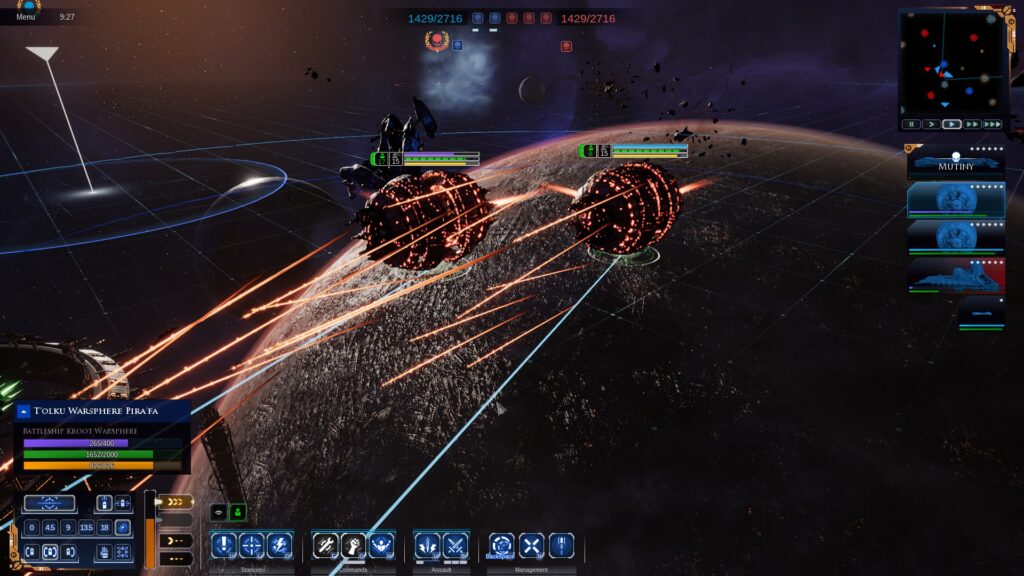
Flaws, complaints, and nitpicks aside, Battlefleet Gothic: Armada 2 is still a solid fleet RTS and a great addition to the massive library of 40k PC games.
The amount of time you can put into it with just the three campaigns alone compares favorably to your average RPG, and on top of that there’s multiplayer with 12 playable factions and the promise of more modes and content in the coming months.
If you don’t like extensive real-time micromanagement, then admittedly Armada 2 probably isn’t for you. If you care to devote the time to learning its mechanics, however, then you’ll find a pretty deep and strategically rewarding game of space combat in the grim darkness of the 41st millennium.
Battlefleet Gothic: Armada 2 was reviewed on Windows PC using a review copy provided by Focus Home Interactive. You can find additional information about Niche Gamer’s reviews/ethics policy here.